The dome was engineered by one man, Filippo Brunelleschi, and he also created several new types of construction equipment that were essential for building the dome. Like the Roman Forum & the Sistine Chapel, I became interested in seeing this landmark because of a book-- In this case, the book is Brunelleschi's Dome by Ross King, who is also the author of Michelangelo and the Pope's Ceiling. I highly recommend it to anyone who has any interest at all in architecture or engineering.
One of the things that I found interesting is that, during the Renaissance, Italians had a very low opinion of the "flying buttresses" prevalent elsewhere in Europe. They viewed the buttresses as a sort of ugly scaffolding technique. And actually, that's exactly what they are-- Well, ugly is up for debate, but they're definitely a structural crutch. The Gothic style was focused on bringing lots of natural light into buildings, primarily by creating high, vaulted ceilings and adding lots of windows. But high walls filled with windows would not have been strong enough to resist the outward thrust created by the arches that were used to construct the roofs, so flying buttresses were added to help provide extra resistance against that thrust. (As walls get taller, they also become less capable of resisting outward thrust.) While Italians did incorporate Gothic-style arches and windows into their churches, they resisted using flying buttresses, making their great churches significantly different from the cathedrals of England & France. (In this case, they did wind up having to implement a different sort of crutch. In the photos below, look for the black iron bars running across the vault. These tension members were added (per Brunelleschi's suggestion) after the main vault was completed, because the walls started to show signs of outward movement.)
Brunelleschi's challenge was to create a massive, octagonal, Gothic-arch-style dome that could be supported by the walls of the church. Fortunately, he happened to be a genius capable of the task, and so his dome still stands today, an architectural masterpiece in the heart of Florence.
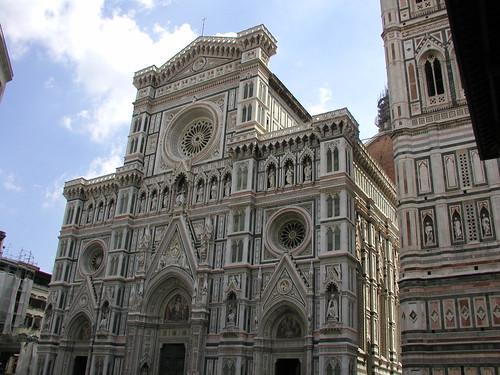
The facade of Santa Maria del Fiore - Every inch of the marble is either intricately carved or inlaid with green or pink marble accents. Up close, the elaborate carvings look like they're made from confectioner's icing and twisted sticks of hard-candy.
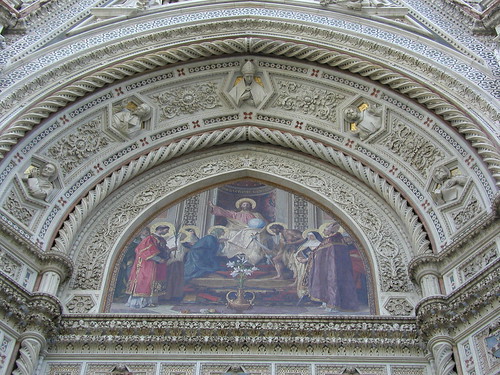
We started our day by checking out of our hotel and reclaiming our car so that we could stash our luggage in its trunk. Then we had to find a place to park the car, which took a while. After that, we set off on foot for the Piazza della Duomo. We stopped at a pastry shop along the way, and sat on a bench outside the church to eat our breakfast. When the gypsies and the Asian-scarf/shawl-vendor-ladies became too much of a nuisance, we decided to get in line. We weren't really sure what we were getting in line for, but that's what you do when you're a tourist in Italy... When you arrive at some famous, amazing site, you get in line. Sometimes it works out the way you were expecting, and sometimes it doesn't. I mention this because a couple of young Italian women approached us while we were in the line, and this is how the conversation went:
Woman #1: "Parlate Italiano?"
Me: "No. Inglese."
Woman #1: *Something in Italian*
Me: *Shrug* "Sorry, I don't know."
Woman #1 to Woman #2: "Como dite i biglietti?"
Woman #2: "Tickets"
Woman #1 to Me: "Si. Tickets?"
Me: "I hope so!"
I'm not sure if she was asking, "Is this the line for tickets?" or "Do you know how much the tickets cost?" It didn't really matter. Even though they hadn't gotten any coherent answers, they shrugged, and got in line with the rest of us tourists, and we all wound up inside the church.
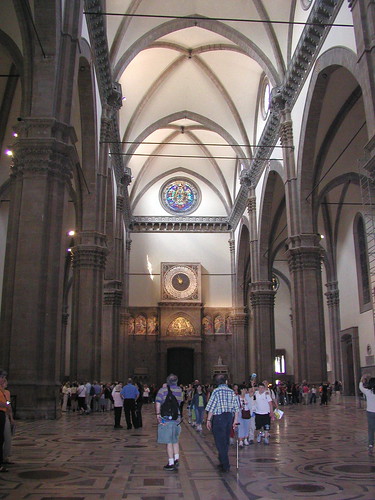
Interior of the church, facing toward the entrance.
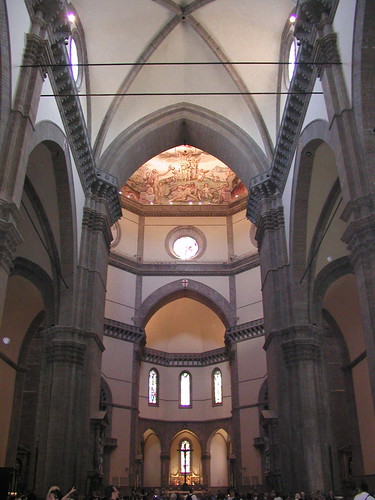
Interior of the church, facing toward the dome.
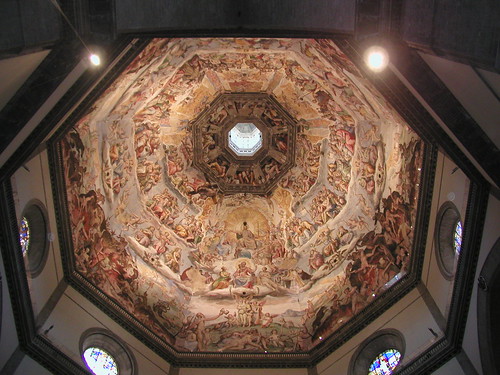
Interior of the dome.
As it turns out, admission to the church itself is free. You do, however, have to pay a fee of 6 Euros (and get in a different line) to go up into the dome. But it was well worth the price, even after factoring in the 463 steps to the top. The climb starts off with narrow stone stairs enclosed between stone walls. The straight staircases change to very tight spiral staircases, twisting upward inside the church walls and into the drum that supports the base of the dome. The drum has two walkways that overlook the interior of the church...
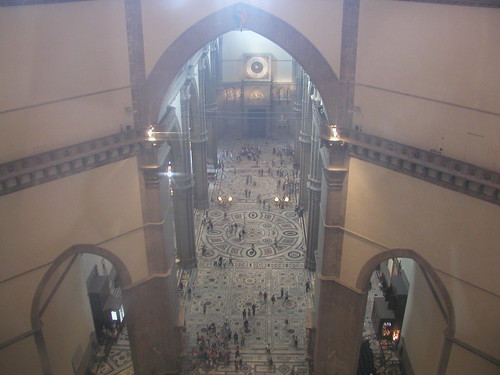
(Sorry about the glare-- They've got plexiglass up along the walkway (presumably so that people can't drop things) and the sunlight from the circular windows in the drum is reflecting off the plexiglass.)
There are actually two massive octagonal domes, with a hollow cavity between them. The lower dome is what you see from inside the church, and the outer dome is the roof that you see from the outside. Both domes were built in rings, without any framing or scaffolding, supporting their own weight as they grew upward. They are capped by a lantern (a tall cylinder with windows) which allows sunlight to illuminate the church through the top of the dome.
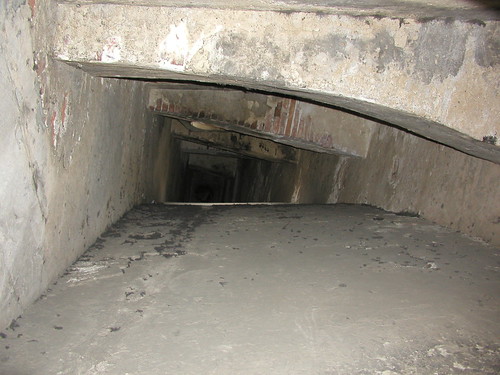
At the base of the dome, the steps become integrated into the surface of the inner dome. They follow a path tangent to the circumference of the dome, slanting at odd angles as they wind upward through the irregular cavity between the two domes. The last set of steps turn toward the center of the dome, climbing directly up the surface of the inner dome.

Finally, there is a stone ladder leading up through the outer dome, so that you escape the cave-like cavity and arrive, blinking in the glare of the sun, at the pinnacle of the dome. From the ledge surrounding the lantern you can see all of Florence stretched out below you, a lake of orange tiled roofs surrounded by the green hills of Tuscany.
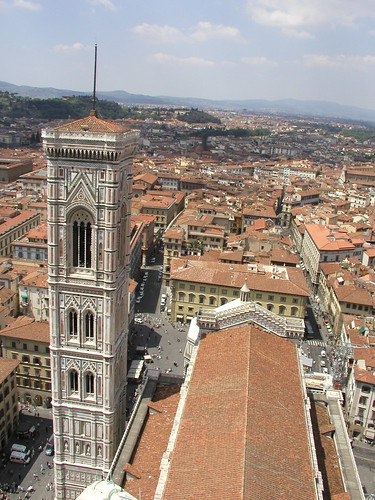
3 comments:
Those pictures are beautiful. I had no idea you were interested in Renaissance Architecture. Why do you think modern churches are so ugly and uninspiring?
Well, since my background is Baptist, not Catholic, and since I now attend church in a building that used to be a big-box hardware store, I guess I'm in a position to play the devil's advocate on this question.
So, if I were chosen to present a defense of the "ugly and uninspiring" side of the debate, my argument would be along these lines:
* According to the Bible, the Church is not a building, it's a group of people who believe that Jesus is the Christ. The first Christians met in people's homes, and in caves, and anywhere else that they could. So clearly, grand buildings are not necessary for (and are quite possibly contrary to) the mission of spreading the gospel of Christianity.
* Secondly, there is the argument for frugality, which goes something like, "Why spend millions of dollars building a hand-carved, gold-plated, stained-glass museum, when that money could be spent feeding the hungry, or sending missionaries to Africa, or sending teenagers to church-camp?"
However, I can also see a lot of merit in the discussion points on the other side of this debate as well. People ought to be inspired by their faith. As one of my pastors once said, "God is not boring. In fact, I believe that it is a SIN to make God boring."
I believe that it's really, really important to have a sense that your life does have a greater purpose than just getting up & going to work everyday to earn a salary so that you can pay for your mortgage & the lease on your SUV and have a wad of money in your 401k when you retire. If that's really all there is to life... That thought is just too depressing to even finish the sentence.
So clearly, we as humans need something more-- We are meant to be a part of something bigger than just ensuring our basic survival.
So, then, what makes a church inspiring?
In all honesty, while I really admire the architecture and engineering that was involved in building the awesome Gothic cathedrals, I also think that there is a significant amount of hubris built into most of them, with this particular church being no exception. The merchants and guilds wanted to establish that the city of Florence was not some backwater hicksville compared to Rome, so they commissioned this church as a monument to their own importance. Religion and faith were secondary. So I admire the church for what it is, a marvel of engineering.
That being said, I will admit that there is still something very powerful and moving about hearing a Schubert or Bach cantata performed in a stone chapel or cathedral. But the churches that I've attended that have that sort of environment also seem to have sermons that lack significance and aren't relevant to my day-to-day life.
On the flip side of that, my church looks like a mixture of a coffee shop, a movie theater, a Chipotle, and a Home Depot, but I always feel challenged by the sermons, and it has profoundly changed the way I look at the world and the people in it.
So which type of church is really more inspiring?
My friend Keith sent me an email (back in October) to reply to my comments, and I think they should be included here:
I'm really sorry I haven't had time to reply to your very insightful comments about religion and architecture. I agree - grand buildings are not necessary - but they are nice and they help to inspire people. I don't doubt that there were other motives for building cathedrals - however, the primary motive was technically for the glory of God. Don't forget - catholics (however backwards you think they are) believe that the corpus christi truly is God in the flesh. Therefore - the church is properly God's actual house - it is then only fitting that it be the best of the best. The works of art were gifts/donations to God - it is only fitting that one offer the best of what one has...anything less would be an insult. Rich people had more to offer - it is true that their donations do reveal their wealth, but should a rich person give less to the church just so other people don't feel jealous? That's a little beside the point - anyway, I completely see your point of view - I just don't see anything wrong with beautiful art and music - I was only commenting how sad it was that art and music are so ugly, boring, and drab these days. Yes, the guts of the church are in the faith and its works, but it's also ok for the building to reflect the beauty within - I dont think that's a sin.
Not being Catholic, I hadn't really thought of a church as being the literal "house of God", but I think it's an interesting point. Looking at things from that perspective, then it certainly makes sense to try to make the building as beautiful and wonder-full as possible. If you believe in the concept of corpus Christi, then you would be dishonoring God to provide anything less than your best.
Now, in my mind, this raises another interesting point. As I said before, in most Protestant faiths, people (Christians) are considered to be the Church, and the Holy Spirit is believed to reside in all of us. According to Paul in I Corinthians 6:19-20:
Do you not know that your body is a temple of the Holy Spirit, who is in you, whom you have received from God? You are not your own; you were bought at a price. Therefore honor God with your body.
That's why Baptists, in particular, believe that you shouldn't drink, smoke, etc. As a temple, your body is supposed to be kept pure.
The senior pastor at my church is always talking about "bringing your A-game" to everything you do. And I think that all of these ideas come together in support of that. If you believe that your soul is a house of God, then you should want to make it beautiful and wonder-full.
Post a Comment